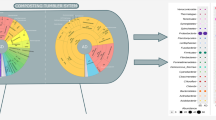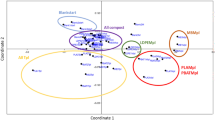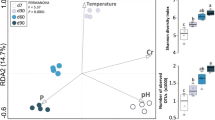Abstract
Composting is a process of stabilizing organic wastes through the degradation of biodegradable components by microbial communities under controlled conditions. In the present study, genera and species diversities, amylohydrolysis, protein and cellulose degradation abilities of culturable bacteria in the thermophilic phase of composting of cattle manure with plant ash and rice bran were investigated. The number of culturable thermophilic bacteria and actinomyces decreased with the increasing temperature. At the initiation and end of the thermophilic phase, genera and specie diversities and number of bacteria possessing degradation abilities were higher than during the middle phase. During the thermophilic composting phase, Bacillus, Geobacillus and Ureibacillus were the dominant genera, and Geobacillus thermodenitrificans was the dominant species. In later thermophilic phases, Geobacillus toebii and Ureibacillus terrenus were dominant. Bacillus, at the initiation, and Ureibacillus and Geobacillus, at the later phase, contributed the multiple degradation abilities. These data will facilitate the control of composting in the future.





Similar content being viewed by others
References
Agrawal M, Pradeep S, Chandraraj K, Gummadi SN (2005) Hydrolysis of starch by amylase from Bacillus sp. KCA102: a statistical approach. Process Biochem 40:2499–2507
Anastasi A, Varese GC, Marchisio VF (2005) Isolation and identification of fungal communities in compost and vermicompost. Mycologia 97:33–44
Bhatia A, Ali M, Sahoo J, Madan S, Pathania R, Ahmed N, Kazmi AA (2012) Microbial diversity during Rotary Drum and Windrow Pile composting. J Basic Microb 52:5–15
Blanc M, Marilley L, Beffa T, Aragno M (1999) Thermophilic bacterial communities in hot composts as revealed by most probable number counts and molecular (16S rDNA) methods. FEMS Microbiol Ecol 28:141–149
Brown M, Foster J (1970) A simple diagnostic milk medium for Pseudomonas aeruginosa. J Clin Pathol 23:172–177
Cahyani VR, Matsuya K, Asakawa S, Kimura M (2003) Succession and phylogenetic composition of bacterial communities responsible for the composting process of rice straw estimated by PCR-DGGE analysis. Soil Sci Plant Nutr 49:619–630
Charbonneau DM, Meddeb-Mouelhi F, Boissinot M, Sirois M, Beauregard M (2012) Identification of thermophilic bacterial strains producing thermotolerant hydrolytic enzymes from manure compost. Indian J Microbiol 52:41–47
Coelho L, Reis M, Dionísio L (2013) Variation in microbial population during composting of agro-industrial waste. Appl Microbiol Biot 97:4179–4186
Danon M, Franke-Whittle IH, Insam H, Chen Y, Hadar Y (2008) Molecular analysis of bacterial community succession during prolonged compost curing. FEMS Microbiol Ecol 65:133–144
de Bertoldi M, Valdini G, Pera A (1983) The biology of composting: a review. Waste Manag Res 1:157–176
Droffner ML, Brinton WF (1995) Survival of Escherichia coli and Salmonella populations in aerobic thermophilic composts as measured with DNA gene probes. Zentralbl Hyg Umweltmed 197:387–397
Ellis RJ, Morgan P, Weightman AJ, Fry JC (2004) Cultivation-dependent and -independent approaches for determining bacterial diversity in heavy-metal-contaminated soil. Appl Environ Microb 69:3223–3230
Fortina MG, Pukall R, Schumann P, Mora D, Parini C, Manachini PL, Stackebrandt E (2011) Ureibacillus gen. nov., a new genus to accommodate Bacillus thermosphaericus (Andersson et al., 1995), emendation of Ureibacillus thermosphaericus and description of Ureibacillus terrenus sp. Nov. Int J Syst Evol Microbiol 51:447–455
Hanajima D, Haruta S, Hori T, Ishii M, Haga K, Igarashi Y (2009) Bacterial community dynamics during reduction of odorous compounds in aerated pig manure slurry. J Appl Microbiol 106:118–129
He JZ, Zheng Y, Chen CR, He YU, Zhang LM (2008) Microbial composition and diversity of an upland red soil under long-term fertilization treatments as revealed by culture-dependent and culture-independent approaches. J Soil Sediment 8:349–358
Ishii K, Takii S (2003) Comparison of microbial communities in four different composting processes as evaluated by denaturing gradient gel electrophoresis analysis. J Appl Microbiol 95:109–119
Kasana RC, Salwan R, Dhar H, Dutt S, Gulati A (2008) A rapid and easy method for the detection of microbial cellulases on agar plates using gram’s iodine. Curr Microbiol 57:503–507
Li R, Zheng JW, Ni B, Chen K, Yang XJ, Li SP, Jiang JD (2011) Biodegradation of pentachloronitrobenzene by Labrys portucalensis pcnb-21 isolated from polluted soil. Pedosphere 21:31–36
Liu J, Xu XH, Li HT, Xu Y (2011) Effect of microbiological inocula on chemical and physical properties and microbial community of cow manure compost. Biomass Bioenerg 35:3433–3439
Marshall MN, Cocolin L, Mills DA, VanderGheynst JS (2003) Evaluation of PCR primers for denaturing gradient gel electrophoresis analysis of fungal communities in compost. J Appl Microbiol 95:934–948
McKinley VL, Vestal JR (1984) Biokinetic analyses of adaptation and cuccession: microbial activity in composting municipal sewage sludge. Appl Environ Microb 47:933–941
Mijangos I, Becerril JM, Albizu I, Epelde L, Carlos G (2009) Effects of glyphosate on rhizosphere soil microbial communities under two different plant compositions by cultivation-dependent and -independent methodologies. Soil Biol Biochem 41:505–513
Ofosu-Budu GK, Hogarh JN, Fobil JN, Quaye A, Danso SKA, Carboo D (2010) Harmonizing procedures for the evaluation of compost maturity in two compost types in Ghana. Resour Conserv Recycl 54:205–209
Steger K, Eklind Y, Olsson J, Sundh I (2005) Microbial community growth and utilization of carbon constituents during thermophilic composting at different oxygen levels. Microb Ecol 50:163–171
Steger K, Sjögrena M, Jarvis A, Jansson JK, Sundh I (2007) Development of compost maturity and Actinobacteria populations during full-scale composting of organic household waste. J Appl Microbiol 103:487–498
Strom PF (1985) Effect of temperature on bacterial species-diversity in thermophilic solid-waste composting. Appl Environ Microb 50:899–905
Takaku H, Kodaira S, Kimoto A, Nashimoto M, Takagi M (2006) Microbial communities in the garbage composting with rice hull as an amendment revealed by culture-dependent and -independent approaches. J Biosci Bioeng 101:42–50
Tamaki H, Sekiguchi YJ, Hanada S, Nakamura K, Nomura N, Matsumura M, Kamagata Y (2005) Comparative analysis of bacterial diversity in freshwater sediment of a shallow eutrophic lake by molecular and improved cultivation-based techniques. Appl Environ Microb 71:2162–2169
Tang JC, Kanamori T, Inoue Y, Yasuta T, Yoshida S, Katayama A (2004) Changes in the microbial community structure during thermophilic composting of manure as detected by the quinone profile method. Process Biochem 39:1999–2006
Tiquia SM, Wan JHC, Tam NFY (2002) Microbial population dynamics and enzyme activities during composting. Compost Sci Util 10:150–161
Vargas-García MC, Suárez-Estrella F, López MJ, Moreno J (2007) Effect of inoculation in composting processes: modifications in lignocellulosic fraction. Waste Manag 27:1099–1107
Wang W, Yan L, Cui Z, Gao Y, Wang Y, Jing R (2011) Characterization of a microbial consortium capable of degrading lignocellulose. Bioresour Technol 102:9321–9324
Yu HY, Zeng GM, Huang HL, Xi XM, Wang RY, Huang DL, Huang GH, Li JB (2007) Microbial community succession and lignocellulose degradation during agricultural waste composting. Biodegradation 18:793–802
Zeng G, Yu Z, Chen Y, Zhang J, Li H, Yu M, Zhao M (2001) Response of compost maturity and microbial community composition to pentachlorophenol (PCP)-contaminated soil during composting. Bioresour Technol 102:5905–5911
Acknowledgments
This research was supported by the National Natural Science Foundation of China (41101231), the National Basic Research Program of China (2011CB100503), the Chinese Ministry of Science and Technology (2013AA102802), the Agricultural Ministry of China (201103004), the Key Technology R&D Program of Jiangsu, China (BE2012377), the Jiangsu Postdoctoral Science Foundation (1102079C), and the Priority Academic Program Development of the Jiangsu Higher Education Institutions (PAPD), 111 project (B12009).
Author information
Authors and Affiliations
Corresponding author
Rights and permissions
About this article
Cite this article
Li, R., Li, L., Huang, R. et al. Variations of culturable thermophilic microbe numbers and bacterial communities during the thermophilic phase of composting. World J Microbiol Biotechnol 30, 1737–1746 (2014). https://doi.org/10.1007/s11274-013-1593-9
Received:
Accepted:
Published:
Issue Date:
DOI: https://doi.org/10.1007/s11274-013-1593-9




